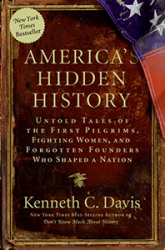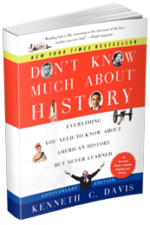(Video edited and produced by Colin Davis; originally posted October 2011; revised October 2022)
Add me to the list. I think it is well past time that we ditched Columbus Day. Cities and states around the country are changing the name of the holiday to “Indigenous People’s Day” or “Native American Day” to move this holiday away from a man whose treatment of the natives he encountered included barbaric punishments and forced labor.
In writing about Columbus over more than thirty years, three points stand out when I consider this day that marks his arrival:
•the eradication of the native people he encountered and misnamed los indios through forced labor, executions, and the spread of diseases. (Read “Isabella’s Pigs” chapter in America’s Hidden History)
•the introduction of African slavery by the Spanish after the death of so many Native American people who had been forced into slavery by the Spanish demanded a new labor supply
•the carryover of Europe’s religious wars to the Americas (a subject also discussed in America’s Hidden History)
Aside from those big ripples of history, we have to unlearn a basic idea– that Columbus thought the world was round. He didn’t. And wrote as much.
I found it (the world) was not round . . . but pear shaped, round where it has a nipple, for there it is taller, or as if one had a round ball and, on one side, it should be like a woman’s breast, and this nipple part is the highest and closest to Heaven.
–Christopher Columbus, Log of his third voyage (1498)
To me this a lot more interesting than…
“In fourteen hundred and ninety-two/Columbus sailed the ocean blue.”
We all remember that much. But after that basic date, things get a little fuzzy. Here’s what they didn’t tell you–
*Most educated people knew that the world was not flat.
*Columbus never set foot in what would become America.
*Christopher Columbus made four voyages to the so-called New World. And his discoveries opened an astonishing era of exploration and exploitation. But his arrival marked the beginning of the end for tens of millions of Native Americans spread across two continents.
So how did we get a holiday for a man who thought the world was a pear?
In 1892, the 400th anniversary of the arrival of Columbus inspired the composition of the original Pledge of Allegiance and a proclamation by President Benjamin Harrison describing Columbus as “the pioneer of progress and enlightenment.” (Source: Library of Congress, “American Memory: Today in History: October 12”)
That was the patriotic American can-do spirit behind the Columbian Exposition—also known as the Chicago World’s Fair of 1893.
In 1934, the “progress and enlightenment” celebrated in the Columbus narrative was powerful enough to merit a federal holiday on October 12 – a reflection of the growing political clout of the Knights of Columbus, a Roman Catholic fraternal organization that fought discrimination against recently arrived immigrants, many of them Italian and Irish.
Once a hero. Now a villain. Calendars now add “Indigenous People’s Day” or “Native American Day” to shift this holiday away from a man whose treatment of the natives he encountered included barbaric punishments and forced labor.
“Indigenous Peoples’ Day recognizes that Native people are the first inhabitants of the Americas, including the lands that later became the United States of America. And it urges Americans to rethink history.”
Here are more resources on “Indigenous People’s Day” from the Teaching Tolerance organization
The story of “Isabella’s Pigs,” and the role of Queen Isabella in the making of the New World, is depicted in America’s Hidden History

